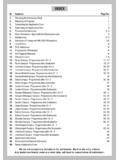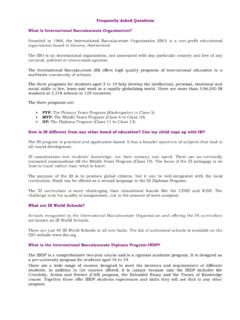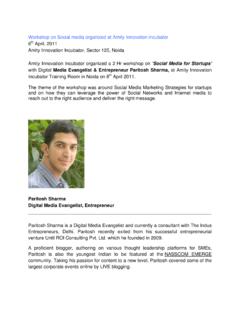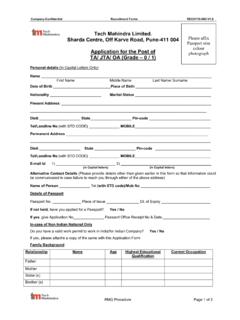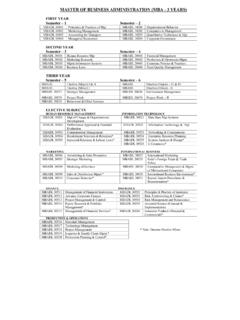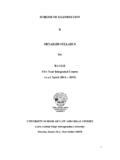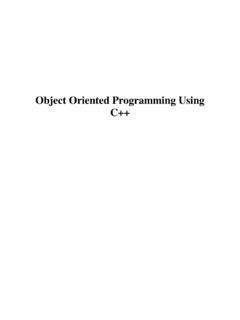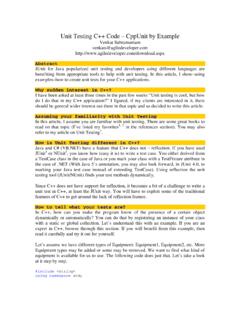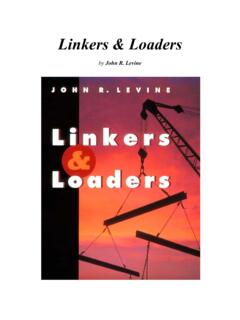Transcription of Bachelor of Technology - Internet of Things
1 Bachelor of Technology - Internet of Things Syllabus - First Semester INTRODUCTION TO COMPUTERS AND PROGRAMMING IN C. Course Code:ITE2104 Credit Units: 03. Course Objective: The objective of this course module is to acquaint the students with the basics of computers system, its components, data representation inside computer and to get them familiar with various important features of procedure oriented programming language C. Course Contents: Module I: Introduction Introduction to computer, history, von-Neumann architecture, memory system (hierarchy, characteristics and types), H/W concepts (I/O Devices), S/W concepts (System S/W & Application S/W, utilities).
2 Data Representation: Number systems, character representation codes, Binary, octal, hexadecimal and their interconversions. Binary arithmetic, floating point arithmetic, signed and unsigned numbers, Memory storage unit. Module II: Programming in C. History of C, Introduction of C, Basic structure of C program, Concept of variables, constants and data types in C, Operators and expressions: Introduction, arithmetic, relational, Logical, Assignment, Increment and decrement operator, Conditional, bitwise operators, Expressions, Operator precedence and associativity.
3 Managing Input and output Operation, formatting I/O. Module III: Fundamental Features in C. C Statements, conditional executing using if, else, nesting of if, switch and break Concepts of loops, example of loops in C using for, while and do-while, continue and break. Storage types (automatic, register etc.), predefined processor, Command Line Argument. Module IV: Arrays and Functions One dimensional arrays and example of iterative programs using arrays, 2-D arrays Use in matrix computations. Concept of Sub-programming, functions Example of user defined functions.
4 Function prototype, Return values and their types, calling function, function argument, function with variable number of argument, recursion. Module V: Advanced features in C. Pointers, relationship between arrays and pointers Argument passing using pointers, Array of pointers. Passing arrays as arguments. Strings and C string library. Structure and Union. Defining C structures, Giving values to members, Array of structure, Nested structure, passing strings as arguments. File Handling. Examination Scheme: Components A CT S/V/Q HA EE. Weightage (%) 5 10 8 7 70.
5 CT: Class Test, HA: Home Assignment, S/V/Q: Seminar/Viva/Quiz, EE: End Semester Examination;. Att: Attendance Text & References: Text: ANSI C by E Balagurusamy 1. YashwantKanetkar, Let us C , BPB Publications, 2nd Edition, 2001. Herbert Schildt, C: The complete reference , Osbourne Mcgraw Hill, 4th Edition, 2002. V. Raja Raman, Computer Programming in C , Prentice Hall of India, 1995. References: Kernighan & Ritchie, C Programming Language , The (Ansi C Version), PHI, 2nd Edition. J. B Dixit, Fundamentals of Computers and Programming in C . Sinha and Priti Sinha, Computer Fundamentals , BPB publication.
6 2. PROGRAMMING IN C LAB. Course Code:ITE2106 Credit Units: 01. Software Required: Turbo C. Course Contents: C program involving problems like finding the nth value of cosine series, Fibonacci series. Etc. C programs including user defined function calls C programs involving pointers, and solving various problems with the help of those. File handling Examination Scheme: IA EE. A PR LR V PR V. 5 10 10 5 35 35. Note: IA Internal Assessment, EE- External Exam, PR- Performance, LR Lab Record, V Viva. 3. Syllabus - Second Semester OBJECT ORIENTED PROGRAMMING USING C++.
7 Course Code:ITE2204 Credit Units: 03. Course Objective: The objective of this module is to introduce object oriented programming. To explore and implement the various features of OOP such as inheritance, polymorphism, Exceptional handling using programming language C++. After completing this course student can easily identify the basic difference between the programming approaches like procedural and object oriented. Course Contents: Module I: Introduction Review of C, Difference between C and C++, Procedure Oriented and Object Oriented Approach. Basic Concepts: Objects, classes, Principals like Abstraction, Encapsulation, Inheritance and Polymorphism.
8 Dynamic Binding, Message Passing. Characteristics of Object-Oriented to Object-Oriented Modeling techniques (Object, Functional and Dynamic Modeling). Module II: Classes and Objects Abstract data types, Object & classes, attributes, methods, C++ class declaration, Local Class and Global Class, State identity and behaviour of an object, Local Object and Global Object, Scope resolution operator, Friend Functions, Inline functions, Constructors and destructors, instantiation of objects, Types of Constructors, Static Class Data, Array of Objects, Constant member functions and Objects, Memory management Operators.
9 Module III: Inheritance Inheritance, Types of Inheritance, access modes public, private & protected, Abstract Classes, Ambiguity resolution using scope resolution operator and Virtual base class, Aggregation, composition vs classification hi rarchies, Overriding inheritance methods, Constructors in derived classes, Nesting of Classes. Module IV: Polymorphism Polymorphism, Type of Polymorphism Compile time and runtime, Function Overloading, Operator Overloading (Unary and Binary) Polymorphism by parameter, Pointer to objects, this pointer, Virtual Functions, pure virtual functions.
10 Module V: Strings, Files and Exception Handling Manipulating strings, Streams and files handling, formatted and Unformatted Input output. Exception handling, Generic Programming function template, class Template Standard Template Library: Standard Template Library, Overview of Standard Template Library, Containers, Algorithms, Iterators, Other STL Elements, The Container Classes, General Theory of Operation, Vectors. Examination Scheme: Components A CT S/V/Q HA EE. Weightage (%) 5 10 8 7 70. Text & References: Text: Venugopal, Rajkumar, T. Ravishanker Mastering C++ , TMH, 1997.
